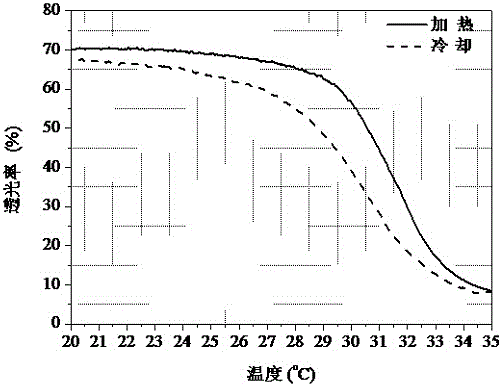Alkoxy ethers temperature-sensitive polymer nanometer microsphere and preparation method thereof
A technology of nano-microspheres and alkoxy ethers, which is applied in the field of alkoxy-ether thermosensitive polymer nano-microspheres and their preparation, and achieves the effects of rapid phase change process, small hysteresis and excellent temperature-sensitive performance.
- Summary
- Abstract
- Description
- Claims
- Application Information
AI Technical Summary
Problems solved by technology
Method used
Image
Examples
Embodiment 1
[0030] Embodiment one: the synthesis of monomer
[0031] (a) The first-generation alkoxyether dendron (G1-CH 2 OH), 1.5 equivalents of p-alkynylbenzoic acid, 0.2 equivalents of N,N-diisopropylethylamine (DIEA) were dissolved in DCM, 1.2 equivalents of EDC·HCl was added in an ice-salt bath under nitrogen protection, and stirring was continued at room temperature until the reaction was complete; after washing with saturated brine, the aqueous phase was extracted with DCM, anhydrous MgSO 4 The organic phase was dried and spin-dried in DCM, and the crude product was purified by column chromatography with DCM to obtain a monomer containing a dendron unit.
[0032] (b) Polymer Poly(Pa-G1-R- co -Pa-CHO) synthesis
[0033] Dissolve the phenylacetylene monomer containing dendrons and p-aldehyde phenylacetylene in a certain proportion in a small amount of THF, and add 1 / 50 equivalent of [Rd(nbd)Cl] under nitrogen protection 2 , Triethylamine (TEA) 1 drop. The reaction was carried ...
Embodiment 2
[0036] The temperature-sensitive behavior of the nano-microspheres was characterized by ultraviolet spectroscopy. as attached figure 2 As shown, the nanospheres at room temperature (25 o C) The light transmittance is higher, 70%, indicating that the solubility and dispersion of the nanospheres in water are better. As the temperature rises slowly to about the phase transition temperature (31.5°C), the light transmittance of the aqueous nanosphere solution drops rapidly. When the temperature rises above the phase transition temperature (35°C), the transmittance is lower than 10%. It shows that the nano-microsphere has excellent temperature-sensitive behavior.
Embodiment 3
[0038] The size of the nanospheres in aqueous solution was characterized by dynamic light scattering. As shown in Table 1, at room temperature (20°C), the size radius of the nanospheres can reach more than 1100nm, and its polydispersity index is 0.491; when the temperature rises above the phase transition temperature (40°C), its size radius is less than 1000nm, its polydispersity index is 4.56, which shows that the size of the smart nanosphere changes with the change of temperature, and it is more stable at room temperature, and its radius distribution is more uniform.
[0039] Table 1. Dynamic light scattering diagram of smart nanospheres.
[0040] Radius (nm) polydispersity index 20℃ 1166.28 0.491 40℃ 803.56 4.56
PUM
| Property | Measurement | Unit |
|---|---|---|
| particle diameter | aaaaa | aaaaa |
| transmittivity | aaaaa | aaaaa |
| polydispersity index | aaaaa | aaaaa |
Abstract
Description
Claims
Application Information
 Login to View More
Login to View More - R&D
- Intellectual Property
- Life Sciences
- Materials
- Tech Scout
- Unparalleled Data Quality
- Higher Quality Content
- 60% Fewer Hallucinations
Browse by: Latest US Patents, China's latest patents, Technical Efficacy Thesaurus, Application Domain, Technology Topic, Popular Technical Reports.
© 2025 PatSnap. All rights reserved.Legal|Privacy policy|Modern Slavery Act Transparency Statement|Sitemap|About US| Contact US: help@patsnap.com



